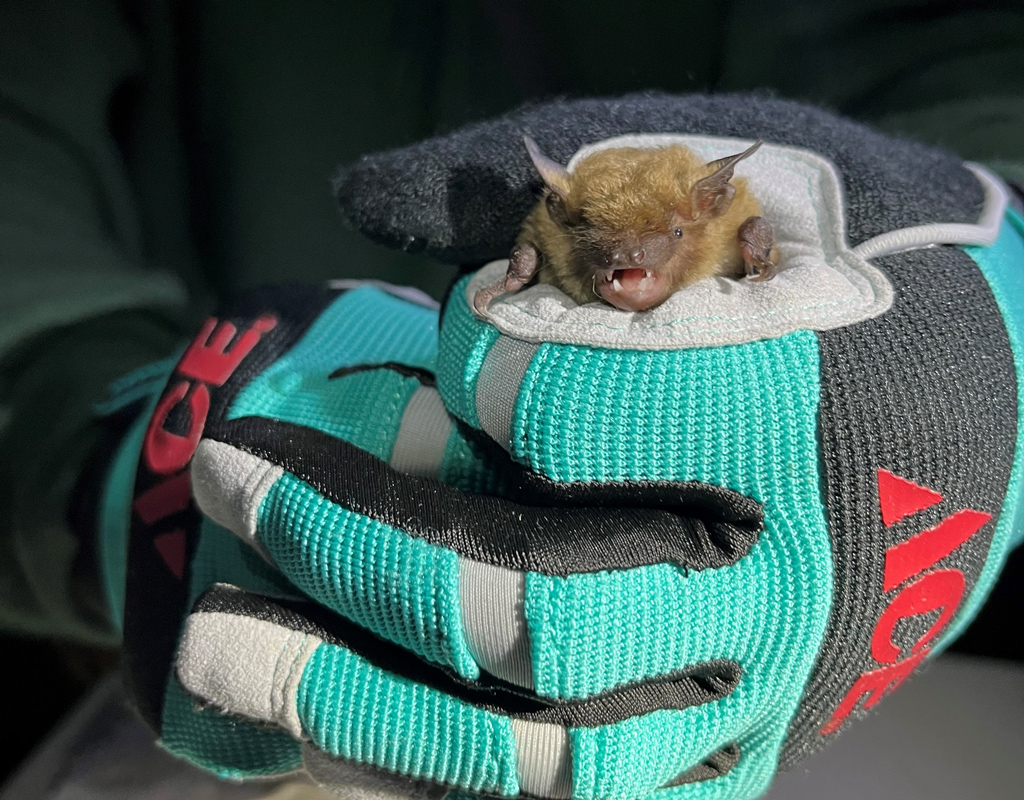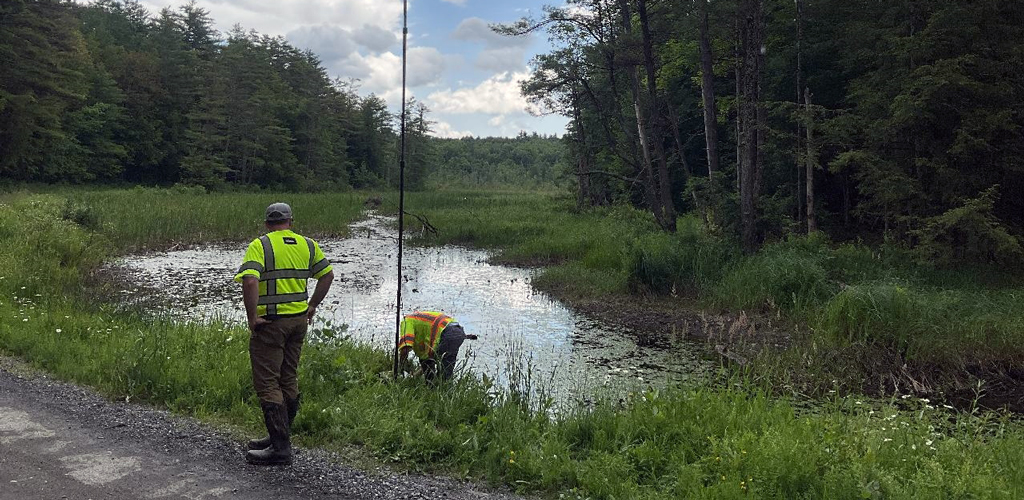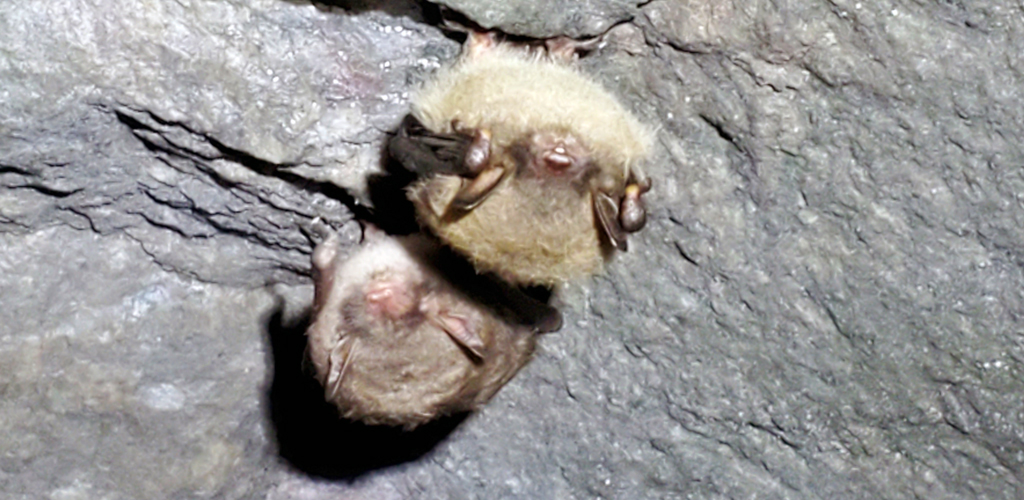
Meg Lout, Senior Bat Biologist at VHB, brings vast experience in the design and conduct of field studies investigating potential impacts of development on rare, threatened, and endangered (“RTE”) wildlife, with a focus on avian and bat species. Meg’s experience includes breeding bird surveys; rocket netting, affixing transmitters to and tracking wading birds; terrestrial and aerial raptor and stick nest surveys; and capture surveys and affixing transmitters to and tracking condors, hawks, songbirds and RTE bats. She has worked throughout the U.S., and in Costa Rica and Australia. Meg is a federally permitted bat biologist and a state-approved bat surveyor in Vermont.
Unbeknownst to many, developments often require surveys to understand how the proposed project might impact RTE species. When RTE bats might be impacted by a project, Meg and her team evaluate the need for a bat survey.
VHB: What interested you in bat/avian biology and how did you get started in the field?
Meg: Years ago, I was a dog groomer at a pet store, and I quickly became enamored by the tropical birds. Before I knew it, I had transitioned to “Bird Associate” and my fascination with these birds prompted me to travel to the old and new world tropics so I could see these birds in the wild. The day after I returned from my first trip to Costa Rica, I switched my undergraduate major from Pre-Vet to Wildlife and Fisheries Conservation, with a focus on avian ecology and conservation. I was introduced to bats by a friend and my first field season of mist-netting made it abundantly clear that my career would involve working with not only birds, but also bats.
VHB: What types of projects impact bats and their habitats?
Meg: Any project that proposes modifications to/demolition of a structure or the removal of trees may directly or indirectly impact bats. Structures and trees with cracks or crevasses often provide a safe location for bats to survive during certain portions of their life cycle. Removal of them during the “wrong” time of year (this varies depending on geographic location) will result in a fatality event. Trees surrounding a roost may protect bats from environmental elements that greatly contribute to a roost’s suitability; removal of them may also result in a fatality event or roost abandonment (a stressor that may ultimately lead to a fatality event). Trees within a quarter of a mile of the entrance to a cave or mine also protect hibernating bats that are lethargic during the winter. If these trees are removed, the narrow range of suitable temperatures and percent of humidity changes, which would result in a fatality event.
Bats also fly along structures and trees that connect the landscape in a way that safely allows a bat to fly short or long distances. Removal of this infrastructure may fragment connectivity and the ability for a bat to fly between and to larger, suitable blocks of habitat. This may isolate a bat population and is likely to contribute to extinction. Tree removal can also impact wetland habitats where insects and foraging exist close to summer roosts, negatively impacting habitat quality and parturition (giving birth to a pup). There are a variety of ways in which a project may impact bats and their habitats. However, projects that create habitat by installing artificial bat roosts, and reforest and revegetate areas that were cleared or selected for mitigation can be extremely beneficial to bats. In my experience, these projects can also provide excellent opportunities for citizens to become involved with bat monitoring.

VHB: Can you talk about your Section 10 permit from the U.S. Fish & Wildlife Service?
Meg: As VHB’s Section 10 permitted bat biologist, U.S. Fish and Wildlife Service approves of my credentials to capture and handle four of the five federally endangered bats (Indiana Bat, Northern Long-eared Bat, Virginia Big-eared Bat, and Gray Bat), or to directly supervise others doing this work who are not permitted.
VHB: What's the process of bat monitoring and what happens when you encounter a bat in the field?
Meg: Bat monitoring begins with a habitat assessment. Essentially, we determine whether the bat species of concern are present or not. We can also assume that RTE bats are present and can bypass the habitat assessment. An example is if a project area includes potential roost trees that bats may use for roosting or as a flight corridor. If a project can adhere to Time-of-Year tree clearing restrictions and the USFWS or state agency approves, the process stops there.
If a project area looks suitable for bats and tree clearing restrictions are challenging for the contractor, we proceed with a presence/probable absence survey to determine if the bats of concern are present or not. This can be determined using two different methods. An acoustic survey is the most common approach, in which echolocation calls are recorded passively with specialized equipment and used to identify which bats are in the area. As an alternative, we can capture bats with specialized netting equipment to identify them in hand. If a species of interest is captured, it is affixed with a transmitter and tracked to understand how it is using an area. This is a more informative approach because we can essentially follow an individual to its roosting location, which may or may not be in the project area. Capture surveys are also used when echolocation calls overlap, such as with the Little Brown bat (not yet federally protected) and Indiana bat (federally endangered). Capture surveys have also been proposed for mitigation purposes.

Having these two presence/probable absence survey approaches allows us to both protect wildlife and help clients move their projects forward responsibly and in accordance with regulations. For example, if targeted species are detected with acoustic monitoring, tree clearing will be delayed until the appropriate season and/or construction restrictions will be required. In cases where the restrictions add significant challenges to the project, we can use a capture survey to confirm whether the species is present in a particular location. In other words, instead of confirming presence through the acoustic survey, which could mean a bat is only flying through the project area, we can figure out how a bat uses the area and potentially get restrictions lifted if a bat is not roosting in or near the project footprint.
Lastly, when a bat species of interest is tracked to its roost, an emergence survey is conducted and at least one person would be present to physically count the number of bats flying out of a roost at dusk.

VHB: How do you handle different bat species across VHB's geographic regions and varied seasons?
Meg: Bat occurrence in any given area is variable, based on seasons and because they are highly mobile animals. It is important to coordinate with state and federal agencies to be certain that proposed activities are not likely to impact bats during different times of the year. For example, in the northeast, winter is the inactive season, and is when tree clearing, and construction activities are unlikely to directly impact bats since they have left the area until spring. Winter in the southeast is a different scenario, as many bats in the northeast (and those more local to the south) migrate to warmer areas to spend the winter.
VHB: The Northern Long-eared Bat (NLEB) was recently listed as an endangered species by the USFWS. What impacts did this have on your project work and are there other species you expect to see listed soon?
Meg: The NLEB was already state endangered in Vermont, so my projects and the ways in which a survey is conducted haven’t changed much. But other VHB offices and clients across the footprint have had to make changes to meet the new requirements.
Bats continue to face challenges such as the spread of white-nose syndrome, climate change, wind energy, and habitat destruction that threaten the habitats upon which they rely throughout the year. The Tri-colored Bat is anticipated to be listed as federally endangered this year, and both the Little Brown Bat and Hoary Bat’s statuses are undergoing review by the USFWS. It is possible that all three of these species, at a minimum, may be federally listed in the next 5-10 years.

VHB: Outside of your role with VHB, are you involved with any professional organizations or groups that support bat work?
Meg: I am very active in the Northeast Bat Working Group (NEBWG) and have held multiple positions including my current role as past president of the board. NEBWG is comprised of agencies, organizations, industry, and individuals interested in bat research, management, and conservation across the Northeast and Mid-Atlantic, although there are also members throughout the U.S. and Canada. I also serve as a board member of the Vermont Bat Center (VBC), and look forward to becoming more involved with the rehabilitation process beginning this winter.
VHB: What changes have you seen over the course of your career?
Meg: When I was starting my career, white-nose syndrome had recently been discovered and killed seemingly endless numbers of hibernating bats. Also, the wind energy industry was growing and directly affected and killed thousands of migrating bats annually. Both disease and the wind industry caused a significant decrease in various bat populations, and their disappearance has become obvious to the general population. Awareness of how bats benefit our ecosystem is probably the biggest change in my career, and people notice this in their daily lives, whether the cost of food has increased from agricultural use of insecticides, getting more mosquito bites, or no longer seeing them flying around on summer evenings like they did as a kid.
VHB: You clearly have a strong appreciation for bats, what do wish more people understood about them?
Meg: I do! Bats play a vital role in our ecosystem, and I wish people understood that we don’t want to know what life is like without them.
At VHB, sustainability is a foundational element to our business, and we are committed to balancing development and infrastructure needs with environmental stewardship, and for me that means protecting these crucial members of our ecosystem.
If you would like to learn more about how VHB’s biologists work to protect threatened and endangered bat species, contact Meg Lout via email.

